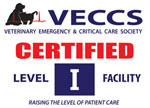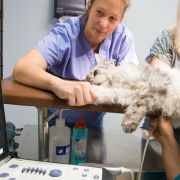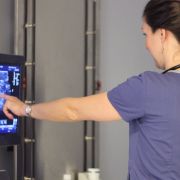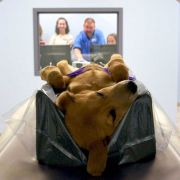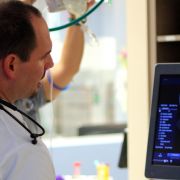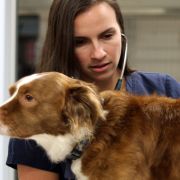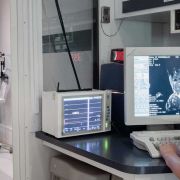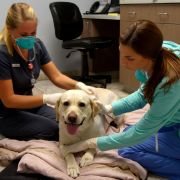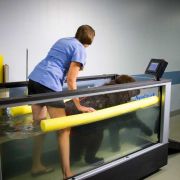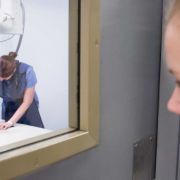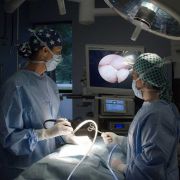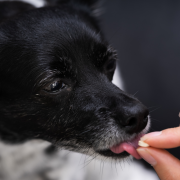Date:
By Erin Stokes
For many dog owners that have experienced it, the word “bloat” can elicit images of terror. It is a common term for Gastric Dilatation and Volvulus (GDV) and it is an unfortunately frequent syndrome seen in our emergency hospital. This month I am pleased to introduce Dr. Erin Stokes, one of CVRC's highly trained emergency clinicians. Dr. Stokes describes the facts about GDV, its symptoms, treatments and methods of prevention.
Many people were introduced to the condition Gastric Dilatation Volvulus (GDV) by the book Marley and Me and its film adaptation. GDV is a serious condition, requiring emergency veterinary intervention. Contrary to the story’s depiction, however, it is not usually fatal if the condition is discovered early and treated as quickly as possible. There are several helpful hints every dog owner should know about this disease.
In conversation GDV is commonly referred to as bloat. Though bloating is an important component of this syndrome, this nickname can be misleading. The distension of the stomach (bloating) occurs when the stomach becomes filled with gas, fluid, or food. Bloating may occur in the presence of absence of volvulus (rotation of the stomach). Rotation of the stomach traps stomach contents, leading to progressive abdominal distension. The increasing size of the stomach leads to complications such as decreased blood flow to internal organs and low blood pressure.
GDV most commonly occurs in large-breed, deep-chested dogs seven years of age or older, but may occur in dogs of any breed or age. Breeds most commonly affected include the Great Dane, St. Bernard, Weimaraner, standard poodle and setters. It is thought that some predisposing factors include eating only one large meal per day, eating rapidly, stressful events or activity after eating. Interestingly, though the veterinary community recommended feeding at-risk breeds from raised food bowls for many years, this practice has fallen out of favor.
Symptoms of GDV include fatigue, a distended or enlarged abdomen, non-productive retching, restlessness, drooling, or acute collapse. Should your dog exhibit any of these warning signs, seek veterinary care immediately. Your veterinarian will likely obtain an abdominal x-ray to assess the size and position of the stomach. A classic “double bubble” appearance of the stomach differentiates twisting of the stomach from gastric dilation (bloat) without volvulus.
Upon diagnosis of GDV, dogs are stabilized for prompt emergency corrective surgery. Veterinarians remove the gas from the stomach by either placing an orogastric (from the mouth to the stomach) tube or by stomach trocharization (placing a needle into the stomach to allow the gas to escape). Fluid therapy and pain medications are also extremely important for stabilization. Surgery for GDV involves derotation of the stomach back to its normal position. The stomach and other abdominal organs (notably the spleen) are thoroughly evaluated for abnormalities that may need to be addressed. During surgery, the surgeon will perform a procedure called a gastropexy. This procedure affixes the stomach to body wall. Gastropexy has been shown to decrease the recurrence rate for GDV. Though gas dilation is possible after a gastropexy, the stomach should not be able to rotate (twist). After surgery, dogs typically need to be hospitalized two to three days for continued monitoring, intravenous fluids and pain management. With swift stabilization and surgical correction, a favorable outcome is seen in the majority of dogs affected by GDV.
Several steps can be taken to help prevent occurrence of GDV. At risk breeds should be fed multiple small meals per day rather than one or two large meals. You should also prevent your dog from rapidly consuming large quantities of food and water. Specialized bowls to help decrease the rate at which dogs eat can be found at most pet supply stores. We now recognize that feeding from raised bowls should be avoided. Just like people, dogs should avoid activity for one to two hours after eating. Prophylactic gastropexy surgery, which is intended to prevent GDV, can be performed for at-risk breeds.
Commonly this surgery is completed at the time of spay/neuter, but it can be done at any life stage. Your veterinarian can help you decide whether this procedure is indicated for your pet. While GDV is not 100 percent preventable, this information is intended to help you recognize the clinical signs and understand what to do if you think your dog may have developed GDV. Charleston Veterinary Referral Center is open at all times for your veterinary needs with a board-certified surgeon on call for dogs that require emergency surgery.



